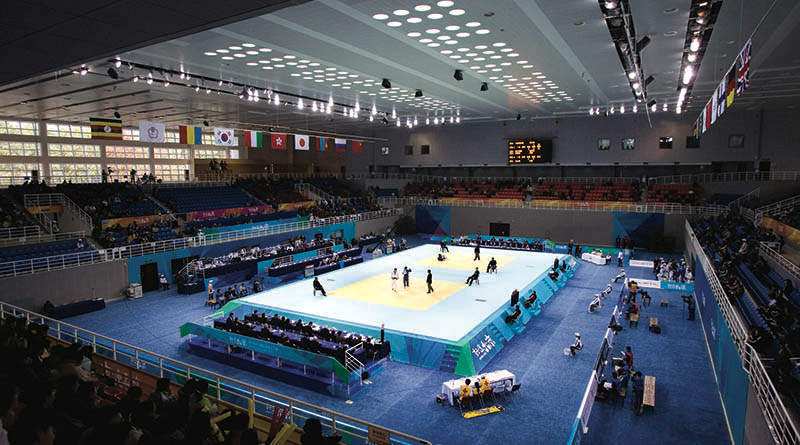Natural Light in Sports and Recreation Spaces: Part 2
By Del Williams

Photo Credit: Solatube
Artificial lighting cannot compare with the aesthetics and sustainable design of bright natural daylight in indoor gyms, sports arenas and recreational spaces.
Daylighting not only enhances the function and beauty of these venues for students, athletes and spectators, but it also makes viewing clearer and colors truer. Functionally, studies have shown that such daylight exposure can also enhance health, energy and mood. Yet too often participants and spectators at these venues find themselves under harsh, artificial electric or fluorescent lighting with minimal exposure to natural light.
In Part 1 of this article, we discussed the benefits of Tubular Daylighting Devices (TDDs), which can direct natural light into sports and recreation spaces through up to 100 feet of highly reflective tubing that can accommodate 45- and even 90-degree angles. Here, we discuss how TDDs are impacting sports and recreation facilities across the globe.
Daylighting Success
At the 2008 Beijing Olympics, when architects were challenged with designing facilities to stringent environmental standards, this had to be balanced with creating competitive sports facilities that satisfied the needs of both athletes and spectators.
Effectively daylighting the Beijing Science & Technology University Gymnasium —which served as an indoor sports facility for a wide range of fitness, aquatics and competitive sports activities — became a crucial design goal in order to reduce the need for artificial lighting. However, it was determined that skylights could not meet the design requirements. The gymnasium’s steel-frame roof also presented a design challenge. In addition to the numerous obstructions, the diffusion plane was nearly 56 feet above the ground.
A daylighting system from Solatube overcame these challenges. First, it allowed daylight to be transmitted more than 26 feet to avoid construction obstacles. Second, the high-performance design provided ample natural light, which was evenly distributed throughout the space. An innovative Daylight Dimmer used a butterfly baffle design to ensure even light distribution in any position, controlled by a wall-mounted switch that allowed easy illumination level adjustments from 2 percent to 100 percent.
“Compared with traditional lighting systems, Solatube daylighting systems have a unique advantage with better progressed view and a wide application field,” said Weimin Zhuang, architect dean, Architecture Design Institute of Qinghua University. “They reduced power usage and exceeded our environmental design goals.”
When Westside Christian High School in Tigard, Ore., began construction of a new gym, incorporating daylight into the school’s gym became a main objective. Administrators wanted students to benefit from exposure to natural light during the school day while reducing the building’s electricity use. This posed a problem, however, because the gym was designated for an interior location with no access to the outside. The original strategy was to install traditional skylights, but concerns about adequate illumination and hot spots prompted the architect to seek other options.
That is when InteriorTech — a building specialty contractor with offices in Seattle, Portland, Ore., and Spokane, Wash. — proposed the use of a daylighting system to meet the administration’s daylighting needs. After reviewing daylight modeling data and comparing output performance to that of traditional skylights, the administration realized that a daylighting system would provide a greater abundance and higher quality of light while reducing energy use.
Upon receiving approval, InteriorTech installed innovative daylighting system units from Solatube for daytime lighting. These modular daylighting units are engineered to deliver massive amounts of daylight to large volume spaces with high, open ceilings. This was complemented by LED lights with timers for nighttime lighting.
Since installing the daylighting system, the school’s gym has become a showcase for natural lighting. The units’ advanced optics capture large amounts of high-quality daylight for abundant output during athletic events, assemblies and concerts. With daylight illuminating the gym, electric lights stay off during the day. This has allowed the school to cut its electricity consumption, lower its utility bills and minimize its carbon footprint.
“In addition to providing such incredible natural light and reducing energy use, the Solatube units are attractive and fit into the overall ceiling structure in such a way that they enhance the beauty of the space,” said Dr. Deborah Miller, head of school for Westside Christian High School.
White Bear Racquet and Swim Club in White Bear Lake, Minn., similarly sought to integrate daylight in many key areas to support its total wellness approach to fitness, provide a more natural and healthful environment, demonstrate its commitment to sustainability and reduce lighting energy requirements.
A Solatube daylighting system was installed that provides full daylight coverage to the entry, reception, main circulation, Ingredients Café and the 10,000-square-foot fitness center. An integrated photo-control system controls the lighting in the day-lit areas, ensuring that the lights are turned off during most of the daylight hours.
The daylighting systems have reduced White Bear’s electric lighting load by half from 115.5 kWh/day to 57.75 kWh/day, or 21,000 kWh/year, while reducing air conditioning load from reduced electric lamp and ballast heat.
“The Solatubes are a significant part of a sustainable retrofit renovation program where daylight allows us to save energy while also improving the interior environment for better member and employee wellness,” said Paul Steinhauser, general partner of White Bear Racquet and Swim Club. “Our goal is to eliminate the use of fossil fuels completely…while increasing awareness in the community on the benefits of sustainable design practices.”
Del Williams is a technical writer based in Torrance, Calif. He writes about business, technology, health and educational issues.

